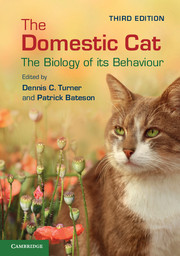16 - Postscript: questions and some answers
Published online by Cambridge University Press: 05 December 2013
Summary
Introduction
When a cat behaves socially towards a human, the person has been treated as though he or she were a cat, although very possibly a particular type of cat. Anybody who loves cats is irresistibly drawn to treat them as though they had some of the characteristics of humans. Cat owners project themselves into the heads of cats and, in so doing, empathise with them. Whether or not they are right to do so raises a big and largely unanswered question. In any event, owners will have seen their cats behave in ways that are often puzzling and enigmatic. Why are they sometimes so friendly and at other times so distant? Those who study the behaviour of cats scientifically are often asked to provide the real answers to such questions. Unfortunately, many aspects of cat behaviour that most interest the lay public have not been the subject of extensive investigation. In part this is because the implied question is: ‘Why does the animal need to behave in this way?’ This is a question about the current utility to the animal of behaving in a particular fashion and is not an easy one to answer. The question also raises questions about the evolution of the domestic cat.
To understand the biological value to the animal of behaving in a particular fashion, scientists ask how the behaviour of a cat, freely living in a natural environment, helps it to survive and breed now. To understand the evolution of the behaviour, they must speculate about the natural environment of the modern cats’ wild ancestors. If some patterns of behaviour have worked to the individual’s advantage better than others in the past and they were inherited, they would eventually tend to be shared by most members of the cat population. The presumption is that by the process of Darwinian evolution, cats behave in a way that is well-adapted to the type of social and physical environment in which their ancestors lived.
- Type
- Chapter
- Information
- The Domestic CatThe Biology of its Behaviour, pp. 231 - 240Publisher: Cambridge University PressPrint publication year: 2013



